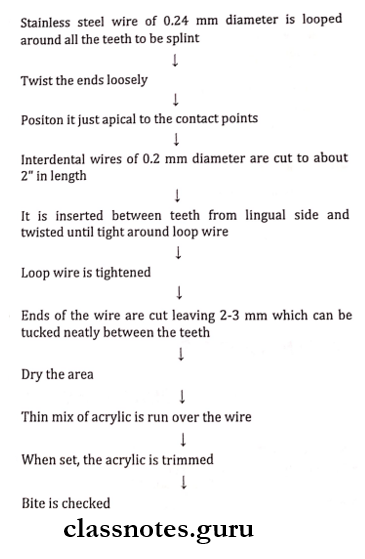Splint In Periodontal Therapy Definition
Periodontal Splint
- A splint is an appliance used for maintaining or stabilizing mobile teeth to their functional position
Splint In Periodontal Therapy Important Notes
1. Classification of splints
- According to the Period of stabilization
- Temporary<6 months
- Provisional – for months up to several years
- Permanent – Indefinite
- According to the type of material
- Bonded composite
- Braided wire
- A-splints
- According to the location
- Intra-oral
- Extra-oral
Read And Learn More: Periodontics Question and Answers
2. Requisites of splints
- Easy to prepare
- Economical
- Rigid, durable, and stable
- Easy to remove and replace
- Self-cleansing
- Easy to maintain
- Esthetically accepted
- Non-irritating to adjacent tissues
Splint In Periodontal Therapy Long Essays
Question 1. Define periodontal splint. Give indications and contraindications for splinting of teeth.
Answer:
Periodontal Splint Definition:
- A splint is an appliance used for maintaining or stabilizing mobile teeth to their functional position
Periodontal Splint Indications:
- Stabilize mobile teeth to improve patient comfort and to provide stability
- Stabilize moderate to advanced tooth mobility
- Stabilize teeth in secondary occlusal trauma
- Stabilize teeth following acute trauma
- Stabilize teeth when increased tooth mobility interferes with normal masticatory function
- Stabilize teeth following orthodontic movement
- Prevent tipping or drifting of teeth
- Create adequate stability
- Prevent extrusion of unopposed tooth
Periodontal Splint Contraindications:
- Presence of periodontal inflammation
- Presence of an insufficient number of nonmobile teeth to stabilize mobile teeth
- Presence of inadequate oral hygiene
- Absence of prior occlusal adjustment
Question 2. Define periodontal splint. Discuss their role as ad adjuncts in periodontal therapy.
Answer:
Periodontal Therapy Definition:
- Splint is an appliance used for maintaining or stabilizing mobile teeth to their functional position
Periodontal Therapy Role Of Splinting In Periodontal Diseases
- Rest
- Immobilization permits undisturbed healing
- Redirection of forces
- Splinting leads to the redirection of forces in the axial direction over all the teeth
- Redistribution of forces
- Distributes forces over a number of teeth and thereby prevents excessive forces on mobile teeth
- Restoration of functional stability
- Restores functional occlusion
- Stabilizes the remaining mobile abutment teeth
- Maintenance of arch integrity
- Proximal contacts are restored
- Prevents food impaction and further breakdown of Loop wire is tightened periodontal tissues
- Psychologic well being
- Restores feeling of dentition, comfort, and esthetics
Question 3. Define periodontal splinting. Mention the ideal requisites of a periodontal splint and write in detail about the splinting procedure.
Answer:
Periodontal Splinting Definition:
- A splint is an appliance used for maintaining or stabilizing mobile teeth to their functional position
Periodontal Splinting Requisites:
- Easy to prepare
- Economical
- Rigid, durable, and stable
- Easy to remove and replace
- Self-cleansing
- Easy to maintain
- Esthetically accepted
- Non-irritating to adjacent tissues
Periodontal Splinting Procedure:

Splint In Periodontal Therapy Short Essays
Question 1. Splints.
Answer:
Splints Definition:
- An appliance is used for maintaining or stabilizing mobile teeth to their functional position.
Splints Objectives
- Provide rest
- By redirecting forces
- Preserve arch integrity
- Restores function
- Stabilizes mobile teeth
- Prevent eruption of unopposed teeth
Splint In Periodontal Therapy Short Question and Answers
Question 1. Permanent splinting
Answer:
- Permanent splints are indicated in dentitions that cannot maintain final stability after periodontal and restorative treatment
- They can be either fixed or removable
- Permanent splints utilizing cast restoration may be placed as part of a restorative phase of therapy
